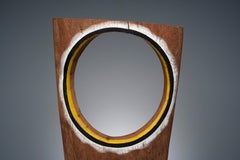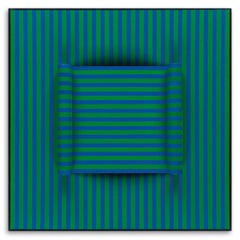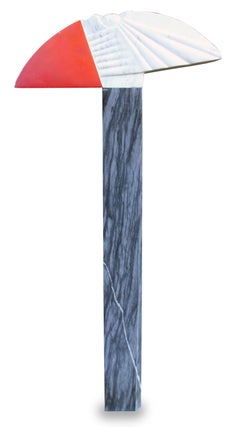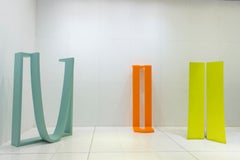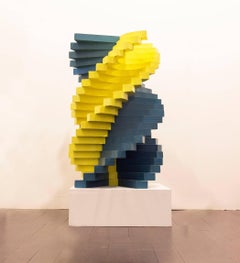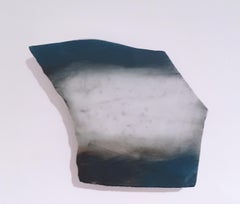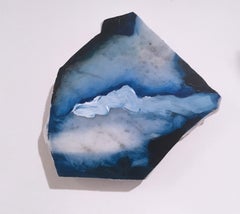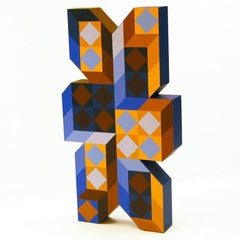Acrylic Abstract Sculptures
to
6
1
3
2
Overall Height
to
Overall Width
to
2
1
77
1,118
1
6
14
16
19
2
1
1
62,156
78
43
31
17
Period: 1960s
Medium: Acrylic
Mid Century Modern Vintage Assemblage Abstract Wall Sculpture Female Artist
Located in Buffalo, NY
Mid Century modern vintage assemblage abstract wall sculpture by Mary Kremer.
Category
1960s Assemblage Acrylic Abstract Sculptures
Materials
Wood, Acrylic
Homage to Kenneth Noland
Located in Washington, DC
Exceptional wood sculpture by Andrea De Zerega (1916-1990). Titled "Homage to Noland." Signed and dated 1968. Base is weighted for stability. Exhibit...
Category
1960s Color-Field Acrylic Abstract Sculptures
Materials
Wood, Acrylic
Acid-Wave
By Omar Rayo
Located in New York, NY
Striking 3-dimensional acrylic and wood on canvas sculpture by renowned Colombian painter an sculptor, Omar Rayo. Signed, titled, inscribed "New Yo...
Category
1960s Op Art Acrylic Abstract Sculptures
Materials
Canvas, Wood, Acrylic
Column, Unique Carved Marble and Stone Column Sculpture by Emile Gilioli
Located in Long Island City, NY
Artist: Emile Gilioli, French (1911 - 1977)
Title: Column
Year: circa 1960
Medium: Carved and Painted Marble on Marble Base, Signature Incised Verso
Size: 65.5 in. x 31 in. x 8 in. (...
Category
1960s Modern Acrylic Abstract Sculptures
Materials
Marble
Threesome
Located in New York, NY
GEORGE SUGARMAN Threesome, 1968-1969
Acrylic on wood
84 3/4 x 156 x 120 inches
Available for outdoor fabrication
Category
1960s Abstract Geometric Acrylic Abstract Sculptures
Materials
Plywood, Acrylic
Yellow and Blue Spiral
Located in New York, NY
GEORGE SUGARMAN
Yellow and Blue Spiral, 1967
Acrylic on wood
33 x 19 x 19 inches
Category
1960s Abstract Expressionist Acrylic Abstract Sculptures
Materials
Wood, Acrylic
Related Items
Untitled "Marble Fragment 1" 2019, acrylic, landscape, wall sculpture, clouds
Located in Jersey City, NJ
Untitled "Marble Fragment 1" 2019, acrylic, landscape, wall sculpture, clouds, purple, blue
Category
2010s Contemporary Acrylic Abstract Sculptures
Materials
Marble
H 6 in W 7 in D 0.75 in
Untitled "Marble Fragment 3" 2019, acrylic, landscape, wall sculpture, clouds
Located in Jersey City, NJ
Untitled "Marble Fragment 3" 2019, acrylic, landscape, wall sculpture, clouds, purple, blue
Category
2010s Contemporary Acrylic Abstract Sculptures
Materials
Marble
H 7 in W 7 in D 0.75 in
GS03, Geometric Abstract Multicolor 3D Mixed Media Wall Sculpture
By Zach Touchon
Located in Beverly Hills, CA
This artwork is part of a series called "Geometric Sculpture" and is a unique 3D sculpture that features a variety of vibrant colors including yellow, orange, red, blue, dark blue, and black. The sculpture is abstract in nature and showcases geometric shapes that add actual depth and space to the piece, making it visually striking and aesthetically pleasing to the viewer.
Zach Touchon has expressed a desire to step outside the traditional square format and focus on movement and 3D effects. As a result, the sculpture creates shadows that further enhance the 3D effect, making the piece truly dynamic and engaging. Touchon has also mentioned his goal to create even larger pieces in the future, pushing the boundaries of the series and the medium itself.
Overall, this artwork is a visually stunning and unique addition to the "Geometric Sculpture" series, showcasing the artist's dedication to creating pieces that challenge traditional art forms and create a sense of depth and movement.
--
Zach Touchon is a contemporary LA-based abstract expressionist artist. Besides that, Touchon is also an actor, a singer, a screenwriter, and an owner of the Touchon Gallery.
Zach Touchon is a second-generation and a successor to his famous father's, Cecil Touchon's, artistic path.
By rethinking abstract expressionism ideas, using different media he creates large abstract artwork along with small collages, huge murals, and interior installations. The main focus of his art is depth and space and finding a semantic and aesthetic balance between them.
As a muralist, Touchon joins the ranks of such great LA street artists as WRDSMTH, Retna, Shepard Fairy, and Dirt Cobain...
Category
2010s Abstract Geometric Acrylic Abstract Sculptures
Materials
Plywood, Acrylic
H 28 in W 46 in D 3 in
Yvette Cohen, Ara Pacis - Zen Corner, 2009, Minimalist sculpture
By Yvette Cohen
Located in Darien, CT
My work bridges the divide between
sculpture and painting and drawing.
Paintings are geometric masses
of color in oil paint and wood dowels,
on shaped canvas. Often grouped in
d...
Category
2010s Minimalist Acrylic Abstract Sculptures
Materials
Acrylic, Canvas, Wood
H 22.5 in W 31 in D 14 in
Nilla (Abstract Mid Century Modern Style Wood Wall Sculpture in Grey & White)
Located in Hudson, NY
abstract three-dimensional wall sculpture, acrylic and wood on panel
carved pieces of wood painted in shades of white, grey and beige with an accent of mint green.
18 x 20 x 2.5 inches, can be oriented vertically or horizontally
Dynamic and graphic wall sculpture...
Category
2010s Modern Acrylic Abstract Sculptures
Materials
Wood, Acrylic, Wood Panel
Reserve, Contemporary Hand-woven tapestry by Ane Henriksen
Located in Wilton, CT
In the eerily beautiful Reserve, Henriksen highlights ecological peril. "Nature is threatened,” she observes. "I hope this is expressed in my image, which at first glance can be seen...
Category
2010s Contemporary Acrylic Abstract Sculptures
Materials
Textile, Rubber, Oak, Acrylic
H 93.75 in W 127.625 in D 2.5 in
Large Abstract Expressionist Papier-mâché Painted Floor Sculpture Vase 1985
Located in Portland, OR
A large abstract Expressionist sculpture floor vase by the celebrated German-American Expressionist artist Peter Robert Keil (b. 1942), signed & dated 1985.
The floor vase is of larg...
Category
1980s Abstract Expressionist Acrylic Abstract Sculptures
Materials
Acrylic, Papier Mâché
Barking Dog, Contemporary artist Keith Haring.
By Keith Haring
Located in La Canada Flintridge, CA
Barking dog
Painted plexiglass sculpture on base. Studio Editions. Signed and numbered 50 copies.
32 x 22 x 3 cm
A certificate from the Publisher is attached to the work
Category
Early 2000s Abstract Expressionist Acrylic Abstract Sculptures
Materials
Acrylic
Assemblage #2 (The Letter E, Glass Slides, and Stamps)
Located in Soquel, CA
Abstract expressionist oil painting with assembled objects by Bay Area artist Michael Pauker (American, b. 1957). Black and bright red expressive brushstrokes are layered with glass ...
Category
21st Century and Contemporary Abstract Expressionist Acrylic Abstract Sculptures
Materials
Glass, Wood, Oil, Plastic, Paper
H 11.25 in W 21.75 in D 0.75 in
“Culture Counter” Red Abstract Contemporary Mixed Media Collage Sculpture
By Brent Fogt
Located in Houston, TX
Colorful abstract contemporary collage sculpture that incorporates pages from 1960 Sears catalogues, cardboard, wood, concrete, acrylic paint, and wood glue. The bright red sculpture...
Category
2010s Abstract Acrylic Abstract Sculptures
Materials
Concrete
H 58 in W 39 in D 20 in
Cube architectural I no. 4/15 - contemporary modern abstract wall sculpture
Located in Doetinchem, NL
Cube architectural I is the first of two free standing contemporary modern abstract wall sculptures from the Architectural-series by French-Dutch artist Olivier Julia...
Category
2010s Abstract Geometric Acrylic Abstract Sculptures
Materials
Wood, Acrylic, Fiberboard
H 5.91 in W 5.91 in D 5.91 in
Sasso Rosa - Sculpture by Vito Difilippo - 2023
Located in Roma, IT
Original sculpture in Polyurethane glue, twine, acrylic, stone.
Certificate by the Artist.
Excellent condition.
Category
2010s Contemporary Acrylic Abstract Sculptures
Materials
Stone
Previously Available Items
Black #1, 1965 Mid Century Modern Painting Shaped 3 Dimensional Canvas
Located in Denver, CO
1965 abstract painting with a 3-dimensional shaped canvas a circular form protruding in the center on a square shaped canvas by Angelo Di Benedetto. Painted in black oil based acrylic. Frame measures 24 ¾ x 24 ¾ x 1 ¼ inches; canvas size is 24 x 24 x 3 ¼ inches.
Painting is in good vintage condition - please contact us for a detailed condition report.
About the Artist:
The son of Italian immigrants from the Salerno province in southern Italy, as a teenager Angelo Di Benedetto worked as a truck driver in the mornings and a bartender in the afternoons to study at the Cooper Union Art School in New York City (1930-34) from which he graduated with a certificate in freehand drawing. He won a scholarship to the Boston Museum Art School where he studied for three years, beginning in 1934, with Russian émigré painter, Alexandre Jacovleff, a member of Mir Isskustva (World of Art) in St. Petersburg before the Russian Revolution. In 1936 he painted a religious mural for St. Michael's Grove in Paterson, New Jersey. The following year he entered his first juried exhibition at the Montclair Museum in New Jersey, winning first prize and first honorable mention.
In December 1938 the Royal Netherlands Steamship Line sent him on a two-month ethnological study trip to Haiti, his first exposure to a different environment outside the United States. During what turned out to be an extended six-month stay, he studied and painted the life and religious customs of the island, resulting in a series of colorful, stylized paintings inspired by his immersion in the local culture. He also did scenes of Port-au-Prince and executed commissions received from prominent people in Haiti, including government officials. In 1940 his Haitian paintings were exhibited at the Montross Gallery in New York (his first solo show) and also reproduced in the January 1940 issue of Life Magazine. One of his Haitian paintings, Morning in Port-au-Prince, was owned by an American author, politician and U.S. ambassador, Clare Boothe Luce, while another image, Haiti Post Office, was acquired for the Encyclopedia Britannica Collection and later donated to Fisk University in Nashville, Tennessee.
Before World War II Di Benedetto traveled extensively around the United States in his car and trailer doing regional paintings. In 1941 he did what is considered the first authentic version of George Washington Crossing the Delaware, a contrast to the well-known painting on the same subject (1851) by German-born painter, Emanuel Gottlieb Leutze. During the war Di Benedetto volunteered for a secret mission to Africa in 1941 before the Allied invasion, serving as director of camouflage, foreman of native laborers and an interpreter while based in Eritrea. The following year he received a direct commission as a Second Lieutenant in the U.S. Army Air Corps in the First Photo Mapping Squadron, leading groups as a guide and interpreter and doing ground control. During his free time in Africa, he sketched and painted the local population and his fellow servicemen.
Following Africa, he served as an orientation officer and aerial photographic officer for the 311th Photo Wing at Bolling Field, in the District of Columbia where he did a series of illustrated articles describing the natives in the different countries where the men of his organization were stationed during the war. In 1945 he was assigned to a mapping unit at Buckley Air Field in Denver where he served until his discharge in 1946.
Like many other servicemen stationed at the time in Colorado, Di Benedetto chose to remain in Colorado impressed by the state's physical grandeur and healthful climate. After the war, he lived briefly for about a year in Rangely, a small town in northwest Colorado where he traveled and sketched. But finding it a little too remote, he settled in the old mining town of Central City in 1947, his home base for the rest of his life. He spent his first six years there transforming the old Sauder-McShane Mercantile warehouse into a giant art studio. His initial acquaintance with the town's mining town history in 1947 resulted in a drawing, Death of a Miner, showing a male figure buried under a pile of collapsed rock in a mining tunnel.
In 1949 Di Benedetto and his wife, ceramist Lee Porzio, opened the Benpro Art School in his studio where he conducted summer art classes. The following year he teamed up with a Denver-based artist, Frank Vavra, to open the Denver Art Center at 924 Broadway. He and Vavra were founding members of the 15 Colorado Artists who seceded in 1948 from the Denver Artists Guild because they were dissatisfied with the older organization's underlying conservatism and the disdain of some of its members for modern art. Welcoming anyone wanting to learn how to draw or paint, the Denver Art Center in downtown Denver only lasted about a year.
Undeterred by its lack of success, Di Benedetto continued throughout his career to give workshops, classes, and lectures on art-related topics in Denver and elsewhere. Examples of topics ranged from subjects such as "African Art," Chappell House, Denver (1945) and "University or Artistic Thought" sponsored by the Art for World Friendship Committee (1954). He also taught locally at the Jewish Community Center, Steele Community Center, International House, Southern Colorado State College-Pueblo, and lectured at the University of Denver. Beginning in 1969 he sponsored over one hundred youths at his studio in Central City to spend a summer learning about art. He also conducted classes for serious working artists. His efforts earned him an honorary doctorate from the University of Colorado in 1977.
He likewise promoted contemporary Colorado artists' work in the 1950s, heading a committee that presented one-person exhibitions in a small gallery at the Vogue Art Cinema on South Pearl Street in Denver. His interest in promoting the arts led to his participation in numerous organizations. In the 1960s he became concerned with environmental and urban art and was the president of Art for the Cities, a Denver-based nonprofit organization. He also was the chairman of and a participant in the first annual environmental art exhibit held at Denver's American Medical Center. In 1968 Colorado Governor John Love appointed him to the Colorado Council on the Arts and Humanities in which he remained active until 1975. He served for two consecutive years as program coordinator for the Governor's Conference on the Arts and Humanities. At the 1969 conference, Governor Love presented him an award for his contribution to the art and artists of Colorado.
At the same time, he actively participated in the civic life of Central City. The town's Police Magistrate (1955-56), he twice campaigned for mayor, first in 1966 and again in 1973, and ran for commissioner in 1979. He socialized with artists Ben Shahn, Herbert Bayer and Mark Rothko, as well as theatrical stars appearing at the Central City Opera House, including Helen Hayes, Mae West, and Gypsy Rose Lee. He invited them to carve their autographs on his kitchen table.
Di Benedetto worked with equal facility in a variety of media: acrylic, oil paint, watercolor, charcoal, Conte crayon, graphic arts and metal (copper, iron). Up until the early 1950s, his output was dominated by representational figure work and expressionist Colorado landscapes that were not always immune from controversy. When Life Magazine included a reproduction of his Regionalist painting, Lovers in the Cornfield (1941) in its article, "Ten Years of American Art: Life Reviews the Record of a Lively, Important Decade" (November 26, 1946, issue), three counties in Massachusetts banned the publication. Just as immediately, the painting was exhibited in Denver. He said that he liked the West because of the people, despite their lack of exposure to art, were individualistic and almost "anarchistic."
In the early 1950s he did woodcuts in a modernist style, including Remembrance, showing his two young daughters. Influenced by Abstract Expressionism at that time, he began considering the elimination of the image from his work. By the end of the decade, he had decided that "the circle – pure and simple was one of the most familiar symbols of mankind and that it metaphored into everything." At the same time, he noted that "99% of the abstract painters shied away from using...[the circle]. When they didn't, they slaughtered it, murdered it and buried it. So it became my motif."
For more than three decades he explored the circle in paint, sculpture and shaped canvas. Two examples of the last-named medium are his Red CQ and Black C-1, both from 1969. Because abstraction touched upon his deep feelings and spirituality, he felt he could make visible that part of life which "we feel but almost never see." His fascination with the circle also relates to his belief that to effect the dialogue existing between object and maker; the artist must "create archetypal shapes [that have universal appeal], not symbols... to reflect simply the intrinsic beauty of the shape itself."
A strong advocate for public art, Di Benedetto headed Art for the Cities, Inc., which sponsored nine sculptures for Burns Park as part of the Denver Sculpture Symposium held in the Mile High City in 1968. The catalysts for the idea of the sculptures were Beverly and Bernie Rosen, who had been instrumental in the creation of the contemporary department at the Denver Art Museum. Along with Di Benedetto, the other participating sculptors were Dean Fleming, Peter Forakis, Roger Kotoske, Tony Magar, Robert Mangold, Robert Morris, Richard Van Buren and Bill Verhelst. The park project eventually served as a prototype for twenty-two states, bringing the sculpture to urban spaces. The sculptures reflected Di Benedetto's concept of "burden-less environmental art" with no hidden meaning for the public to decipher. His goal in public art was to "create a work which, when integrated with the site, will create a tranquil oasis, a counterbalance to the modern chaotic world we experience daily."
During the 1960s and 1970s, he received other major sculpture commissions: an 80-foot-long copper wall, Jewish Community Center, Denver (1962); sculpture garden, General Rose Hospital, Denver (1964); Fountain, First National Bank of Dallas (1966); Colorado Fuel & Iron Company, Pueblo, Colorado (1969); neighborhood park sculpture, Yonkers, New York (1971); High School Park, Northglenn, Colorado (1974); ice skating rink sculpture, Pueblo (1976).
Fate was not as kind to his mural which the Colorado Supreme Court justices commissioned him to paint in 1976 for the Colorado Judicial Building from a field of twenty-two candidates. With his former student, Phyllis Montrose as his principal assistant along with three others, he spent a year and a half executing the mural. Entitled Justice Through the Ages (aka Lawgivers), it depicted sixty individuals from ancient Babylon...
Category
1960s Abstract Acrylic Abstract Sculptures
Materials
Canvas, Acrylic
H 24.75 in W 24.75 in D 3.25 in
Ter-A-2 (Blue Gold)
Located in Toronto, Ontario
Victor Vasarely (1906-1997) is considered as the father of the Op Art movement.
Typically the best examples of this genre display hypnotic abstract patterns that seem to be in moti...
Category
1960s Abstract Geometric Acrylic Abstract Sculptures
Materials
Wood, Acrylic
Axo-AB
Located in Toronto, Ontario
Victor Vasarely (1906-1997) is considered as the father of the Op Art movement.
Typically the best examples of this genre display hypnotic abstract patterns that seem to be in moti...
Category
1960s Abstract Geometric Acrylic Abstract Sculptures
Materials
Acrylic, Wood
Ter-A-2
Located in Toronto, Ontario
Victor Vasarely (1906-1997) is considered as the father of the Op Art movement.
Typically the best examples of this genre display hypnotic abstract patterns that seem to be in moti...
Category
1960s Abstract Geometric Acrylic Abstract Sculptures
Materials
Wood, Acrylic
"Spectrum" Colorful Painterly Rippled Wall Sculpture
By Gary Jurysta
Located in Houston, TX
Colorful rippled structure with a convex shape. The painting has red, green, blue and pink tones. The edges of the canvas have a rippled effect along with the center of the hand-made...
Category
1960s Modern Acrylic Abstract Sculptures
Materials
Wood, Acrylic
"Current" Red Rippled Painted Wall Structure
By Gary Jurysta
Located in Houston, TX
Red geometric rippled canvas that extends into the plain of the viewer. The handmade canvas has a rippled effect that creates a 3-dimensional effect. The artist signed, titled, and d...
Category
1960s Modern Acrylic Abstract Sculptures
Materials
Wood, Acrylic
Enameled Resin and Metal Pop Art Sculpture in Sunflower Yellow, Bubble Gum Pink
Located in New York, NY
This idiosyncratic and powerful sculpture, with its vibrant color scheme and dynamic form, encapsulates all of the energy of pop on an intimate scale. The enamel green base with blac...
Category
1960s Pop Art Acrylic Abstract Sculptures
Materials
Metal, Enamel
H 6.75 in W 9 in D 4.5 in
Acrylic abstract sculptures for sale on 1stDibs.
Find a wide variety of authentic Acrylic abstract sculptures available on 1stDibs. While artists have worked in this medium across a range of time periods, art made with this material during the 21st Century is especially popular. There are many well-known artists whose body of work includes ceramic sculptures. Popular artists on 1stDibs associated with pieces like this include Victor Vasarely, Jozef Bajus, Lia Cook, and Garth Evans. Frequently made by artists working in the Abstract, Contemporary, all of these pieces for sale are unique and many will draw the attention of guests in your home. Not every interior allows for large Acrylic abstract sculptures, so small editions measuring 1.58 inches across are also available Prices for abstract sculptures made by famous or emerging artists can differ depending on medium, time period and other attributes. On 1stDibs, the price for these items starts at $165 and tops out at $585,000, while the average work can sell for $6,101.
Recently Viewed
View AllMore Ways To Browse
Virgil Abloh Vitra
Virgil Vitra
Travertine Cat
Joey Watson On Sale
John Garrett On Sale
Marko Kratohvil On Sale
Martin, Gerardo & Juan Carlos Salgado Castrejon On Sale
Cy Gavin
Paul Gershowitz
Virgil Abloh Block
Virgil Abloh Ceramic Block
Willem Degroot
Arline Sherman Art
Yvon Cochery
Rachel Hubbard Kline Clamshell Tiles
Hiroyuki Shindo
Lee Musselman
Janusz Bronze
